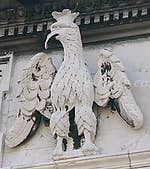Palazzo Labia
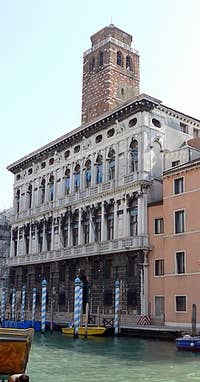
The Labia palace and its Bell tower The Labia palace was constructed during the first half of 18th century by the architects Andrea Cominelli for facades overlooking channels.
And also constructed by Alessandro Tremignon (who also designed the front elevation of the San Moisè church) for the facade overlooking the Campo San Geremia.
The architecture is Venetian baroque style.
It is located at number 275 in Cannaregio.
A Hundred Thousand Ducats to Enter the Order of the Patricians
In 1646 Labia gave a hundred thousand ducats to be admitted to the order of the patricians.And they could build the vast building of Saint Jérémie, where they gave a feast for forty gentleman served on gold dinnerware.
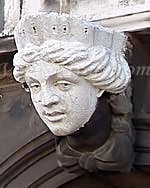
Sculpture Labia palace President De Brosses tells of his voyages in Italy, that :
“Everybody was going to see diamonds of Labia, who did not fear the comparison with those of the princesses and of queens.”
Molmenti translated from La Vie Privée à Venise - 1882
Sumptuous Feasts!
Gold dinnerware Thrown into the Grand Canal!
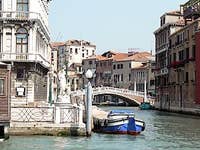
The Labia side Grand Canal Labia gave the first presentation of the Caieto de Bertoni in their palace and being renowned for their opulent receptions.
They even say that at the end of feasts they threw their gold dinnerware into the channel.
And the scandalmongers tell that the following day, the servants inconspicuously recovered it with fishnets which had been placed prior day on the bottom of the channel in anticipation of the throwing of plates!
In 1739, de Brosses eyes up Jewelry …
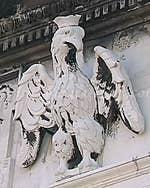
Eagle Facade Labia palace
“The Labia palace, constructed in a modern style, is the only one of course that I viewed from the inside.
The mistress of the home, a woman who was past one's prime , was extremely beautiful and extremely gallant, mad about the French, and as a result us, displayed all her gems for our view, the nicest perhaps that any private individual of Europe has.
She had four complete sets of emeralds, sapphires, pearls and diamonds; with everything preciously contained in jewel cases; because the wives of the noblemen can not wear gems and clothes of color, they are not allowed to adorn with it, after the first year of their marriage.
Eagle Facade Labia palace I offered her to lead her to France along with her jewels.”
Charles de Brosses
translated from Lettres familières -1739
From Owners to Owners...
The Labia family could no longer maintain it and sold Palazzo Labia at the beginning of 19th century to the Prince Lobkowitz.The Prince, in turn sold it to a Viennese Israelite establishment who cut it up in flats and sold the bulk of the furniture and the works of art that were there all at once.
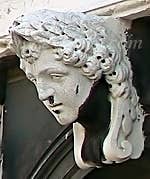 In 1890 the city of Venice establishes a school on the ground floor but this occupation is short-term.
In 1890 the city of Venice establishes a school on the ground floor but this occupation is short-term.
It is then acquired before the second world war by the Prince Labbia (unrelated to the Labia family).
But, blow of fate, there 1945 a boat loaded with munitions blows up on the Grand Canal and harms the palace as well as the famous frescoes of Tiepolo which are there.
Piqued, the prince Labbia sells the Labia palace then to Charles de Beistegui.
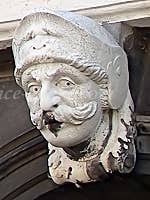 Beistegui made numerous alterations, not always very respectful of the architecture of the Palace, and at the end, he also sold it.
Beistegui made numerous alterations, not always very respectful of the architecture of the Palace, and at the end, he also sold it.
In 1963 the Italian television channel RAI purchases it and has had its headquarters there since.
An Imposing block
Its mass and its rather imposing facade gave rise to authors' numerous texts.“It entered the first streets of the Ghetto which he acknowledged in the blown and pale faces of the inhabitants, in Hebrew inscriptions, in ritual butcheries, where one flavorless reek wafted.
Again a bridge, and the Labia palace raised its imposing mass, the caryatids of its columns refined and gnawed by time.”
Jacques Adelswärd-Fersen
translated from: Notre-Dame des Mers Mortes - 1902
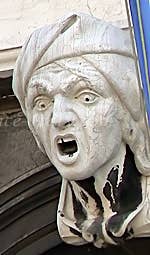
“Then it is the Labia palace which develops its sumptuous facade, announcing more spent silver than of taste and style.
It cost four and a half millions; they say it at least, and I believe it easily.
It proves one more time that good taste is rarer than ecus.
Indoors, the Labia palace contains a big room covered with frescoes by Tiepolo; it is one of the nicest works of this memorable master.
In this title, this vast palace deserves that we returned him his greeting.”
Havard
translated from: Amsterdam et Venise - 1876
Next Page: Sculptures and Frescoes of Tiepolo
Back to Top of Page


